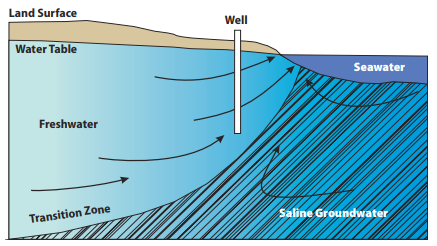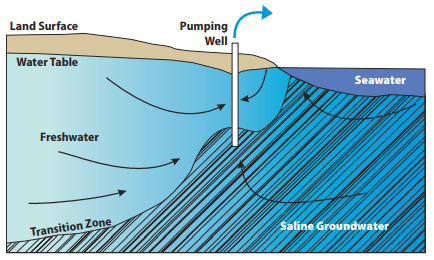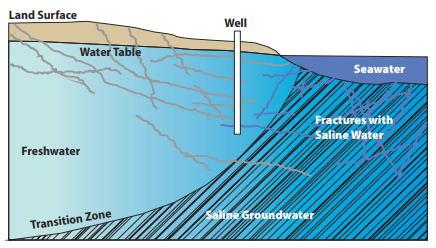Seawater Intrusion and How to Prevent It
Published on by Marina A, Previously Key Account and Content Manager at AquaSPE AG in Academic
Saltwater intrusion is the induced flow of saltwater into freshwater aquifers due to over-deployment of groundwater. It makes the water from wells salty and undrinkable but some practices are able to prevent this.
The migration of seawater from the sea towards a well will occur if the groundwater from the aquifer is being over-pumped and there is a hydraulic connection between the groundwater and the sea.
Groundwater flows from the area with higher to lower groundwater levels and prevents the seawater from entering the fresh water aquifer.
Fresh water creates a buffer at the freshwater-saltwater interface - the zone of dispersion. The boundry between fresh and salt water is indistinct as these water these waters mix at the interface. Fresh water has lower density and will stay on top of dense salty water.
If more water is pumped from the wells than is replenished by rain or recharged, groundwater levels decrease and saltwater can enter the freshwater aquifers.

Image: An equilibrium between fresh and saline groundwater at depth, under non-pumping conditions there.
Image source: www2.gov.bc.ca/assets/gov/environment/air-land-water/water/water-wells/saltwaterintrusion_factsheet_flnro_web.pdf

Image: Upcoming or inland movement of the freshwater-saltwater interface can occur due to pumping or other disturbances (e.g. sea level rise, reduced recharge). If a single well is overpumped or multiple wells are pumping, a large area of the aquifer may be impacted by salinity.
Image source: www2.gov.bc.ca/assets/gov/environment/air-land-water/water/water-wells/saltwaterintrusion_factsheet_flnro_web.pdf
As little as 7 tablespoons of salt added to a full bathtub is enough to make the water undrinkable.
Saltwater intrusion reduces the availability of fresh water.
Saltwater intrusion can happen in two cases:
Lateral intrusion of sea water because of overpumpming from the wells
Deeper saline water movement due to to upconing near coastal wells.
To prevent saltwater intrusion, some of the rules for well drilling should be followed:
Well location – at least 50 m from the coast
Well depth – avoid deep wells close to the coast.
The depth of the freshwater-saltwater interface depends on a variety of factors and should be established locally with the Ghyben-Herzberg formula.
Special attention needs to be paid if bedrocks are fractured.

Image: In a fractured bedrock aquifer a single fracture can deliver saltwater to the well.
Image source: www2.gov.bc.ca/assets/gov/environment/air-land-water/water/water-wells/saltwaterintrusion_factsheet_flnro_web.pdf
Hydrofracturing should be avoided in areas closer than 100 m from the coast, to avoid the risk of open fracturing.
Monitoring during drilling – using a hand-held meter to measure conductivity and stop drilling if the conductivity drastically changes. It may be necessary to seal the well below a certain depth to prevent salty water from entering.
To prevent saltwater intrusion, some of the rules for well operation should be followed:
Reduce water use
Reduce pump depth
Pump less water more frequently
Coordinate the pumping in a multi-well system so it is not simultaneous
If the well is pumping saline water due to saltwater intrusion, stop using it for a period of time in which it can possibly recover. However, the damage to the water well may be irreversible.
The best way to prevent saltwater intrusion is to continually monitor:
Electrical conductivity:
An aqueous solution has the ability to carry electrical current via ionic motion.
Conductivity increases with the increase of salinity (total dissolved solids, TDS).
Sea water has a higher concentration of chloride in the water and (19,000 mg/L) so electrical conductivity can be used as a relative measure of chloride concentration.
Conductivity is measured at 25°C and reported in microSiemens per centimeter (µS/cm) and TDS in mg/L.
Electrical conductivity can be measured with:
- Hand-held meters: measurements after the water is pumped from the well
- C-T-D transducers: transducers which measure conductivity, temperature and depth are installed in an access tube in the well.
- In-line meters: installed in the discharge line.
- Real-time monitoring: there are systems which monitor and detects salinity changes and sent alerts so that an alternate water source can be found. One of such systems is the imaGeau2.
- Solinst Model 107 TLC Meter:
- Solinst Model 107 TLC Meter measures temperature, level and conductivity.
Since conductivity depends on the temperature, measuring both the variables is important for establishing the freshwater-saltwater interface.
The device measures the parameters at a certain depth and contains a smart probe which makes accurate measures.
- LTC Levelogger Edge:
LTC Levelogger Edge is a compact, low-maintenance device for continuous monitoring of conductivity, temperature and water levels.
It can make measurements every 5 seconds.
Groundwater level measurements:
The level of groundwater is measured within the well and the pump can be set to automatically shut off if the water level is below a certain point.
Groundwater levels can be maintained by ponding surface water and stormwater runoff or recharging groundwater using river water.
Aquifer Storage and Recovery (ASR) systems can help restore aquifers.
Deep well recharge has been found to be successful in controlling saltwater intrusion.
Water metering:
With the overview of much water the well owner is pumping and using, a clear picture of the water consumption is gained and conservation is encouraged.
CRYSTECHSALIN:
One of the solutions for preventing saltwater intrusion is crystallization technology.
CRYSTECHSALIN stands for Crystallisation technologies for prevention of salt water intrusion.
CRYSTECHSALIN is used to reduce the permeability of the geological rock formations that act as a barrier for the coastal aquifer.
The crystallized solution of slightly soluble minerals from over saturated solution is artificially induced and changes the rock porosity and prevents the saltwater from entering the aquifer.
The crystallization process interacts with soil and geologic rock formations turning into a grout like binding agent and creating a seal for saltwater.
Sources:
Media
Taxonomy
- Groundwater
- Saline Water
- Aquifer Recharge
- Groundwater Recharge
- Aquifer Recharge
- Groundwater Assessment
- Groundwater Salinisation
- Groundwater Quality & Quantity